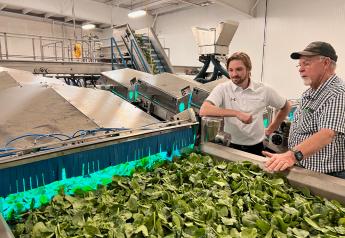Wisconsin potato outlook strong

Harvest will pick up steam in August for the 2021 Wisconsin potato crop.
Sources said acreage won’t be much changed from a year ago, and the crop outlook is generally favorable, though weather factors could influence the outcome of the crop through the end of harvest this fall.
Crop story
The Wisconsin potato planting season started about 10 days earlier than usual, with south-central and central Wisconsin beginning in early April, said Dana Rady, director of promotion and communication and consumer education for the Wisconsin Potato & Vegetable Growers Association, Antigo.
“The potatoes look pretty good at this point despite the stretches of dry weather,” said Larry Alsum, owner and CEO of Alsum Farms & Produce, Friesland, Wis.
Because of the dry weather, Alsum said the company has been irrigating potatoes more than normal.
“So far we are able to stay ahead of it,” he said.
“So far, the crop is looking good,” said Mike Carter, CEO of Bushman’s, Rosholt, Wis. “The crop has rebounded nicely from (hot weather in June) so that we’re really not seeing any effects at all.”
Carter said he anticipates an “average” potato crop.
“I think our volumes are going to be really consistent with where they’ve been in the last couple of years,” he said.
Potato sizing appears typical, Alsum said.
“The size profile is almost ideal, with the right sizes that you want for the variety of customers we have,” he said.
Rady said the weather was very cool in April and May, with below-normal temperatures slowing crop progress.
“There was also a frost Memorial Day weekend that nipped some emerged potato plants and could reduce yields on a few hundred acres,” Rady said.
Temperatures warmed up after Memorial Day weekend and were followed by extreme heat and dry conditions throughout Wisconsin the first half of June, she said.
“We saw record high temperatures during this time and prolonged periods of drought,” Rady said.
Rains came in mid- to late June with temperatures returning to normal.
“Despite these weather challenges, the overall crop conditions are very good, although the extreme heat may have reduced the potential for high yields,” Rady said.
Fresh potato fields are typically irrigated and so growers have been able to cope with the dry weather, said Paul Mitchell, professor of agricultural and applied economics and University of Wisconsin extension specialist. In addition, growers have been able to avoid the massive 4-inch rainfalls that can cause problems for the crop.
Most Wisconsin potatoes are grown in the sandy central part of the state, though there are pockets of production in northwest Wisconsin and in the Wisconsin River Valley in the south-central and southeastern parts of the state.
Mitchell said many growers are part of the Healthy Grown program from the Wisconsin Potato & Vegetable Growers Association, which is a sustainable standard for growing potatoes in the state.
Acreage flat
Wisconsin acreage is expected to stay flat with some growers making slight fluctuations between certain varieties and others shifting slightly between reds and yellows, Rady said.
Alsum Farms should have nearly identical acreage to a year ago, Alsum said. Acreage of red potatoes was cut back a little, increased on yellow-flesh potatoes and was about steady for russets.
Yields may be average this year, limited by early season cooler weather and extreme heat in June.
For Alsum Farms, harvest will start in early August, a couple of days later than a typical harvest start because of the hot weather in early June.
Market talk
One of the bigger challenges that growers saw this year is a somewhat slower retail market on reds and russets compared to the previous year with the height of the pandemic, Rady said.
“There was a significant amount of panic purchasing occurring a year ago, and now that foodservice is making a slow rebound, retail is balancing out a bit more,” Rady said.
Retail potato demand was extremely strong in March and April last year when the COVID-19 pandemic hit, Alsum said.
Strong demand continued on for most of the year and through the holidays.
“We had really good value and good prices last year,” Alsum said.
For the past six months, retail demand has not been quite as robust as a year ago.
“I think our economy is just struggling to kind of redefine normal and foodservice is back, but it’s not quite what we had before,” he said.
Even with lower prices now, Wisconsin growers are still making a profit, he said.
Shipping point prices on July 27 for Wisconsin 60-count russet norkotah potatoes were $19-20 per carton, compared with about $20-21 per carton the same time last year.
Wisconsin potato cartons of 5 10-pound bags sold for mostly $8.50-9, down from mostly $10.50-11.50 the same time last year.
Wisconsin potatoes also boast a substantial freight advantage to Eastern and Midwestern destinations compared with Northwest potato shippers.
For example, the July 21 refrigerated truck rate to Chicago from central Wisconsin was less than $1,200, compared with up to $4,250 for refrigerated trucks from Idaho to Chicago. For a truck with 1,000 (40-pound) cartons, the truck rate to Chicago from central Wisconsin was $1.20 per carton. That compares with a hypothetical rate of $4.25 per carton for shipments from Idaho to Chicago.
“Anything going East, we have a nice (truck rate) advantage,” Carter said.
Alsum echoed that thought.
“We have a huge advantage in Wisconsin of being close to market and we’ve learned how to take advantage of that,” Alsum said.
The company has recently purchased six tractor trailer rigs that will help with harvest and also ship potatoes to customers in nearby cities.
Potatoes continue to be America’s favorite vegetable, and Rady said Wisconsin potatoes offer consumers a big bang for the buck.
“They are easy to make and are so versatile while also providing the most nutrients per penny from a health standpoint,” she said.
Carter said potatoes are an essential item for consumers.
“One of the things that the pandemic taught us was, no matter what, people still have to eat, regardless of where they’re buying their product,” he said.







